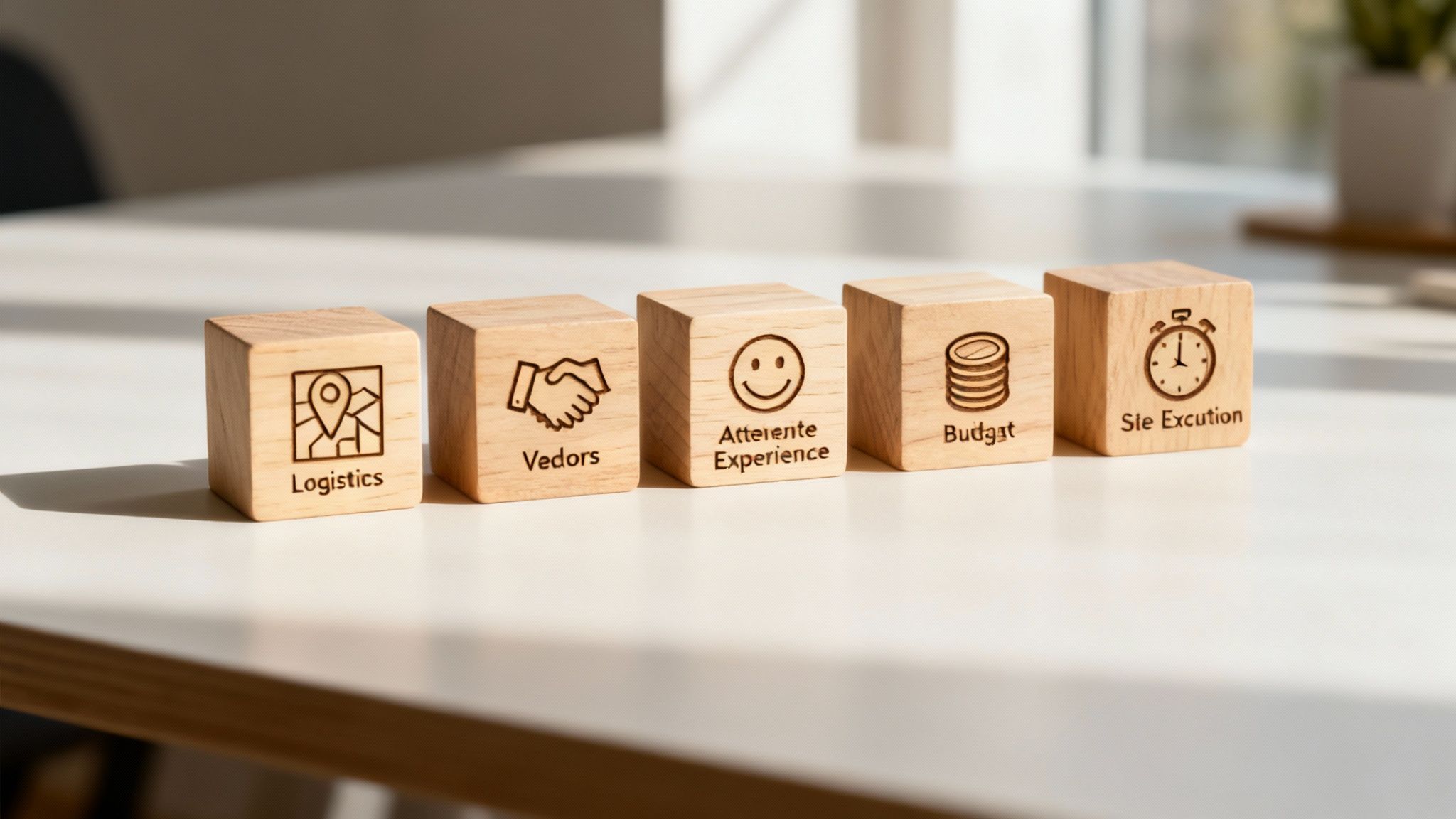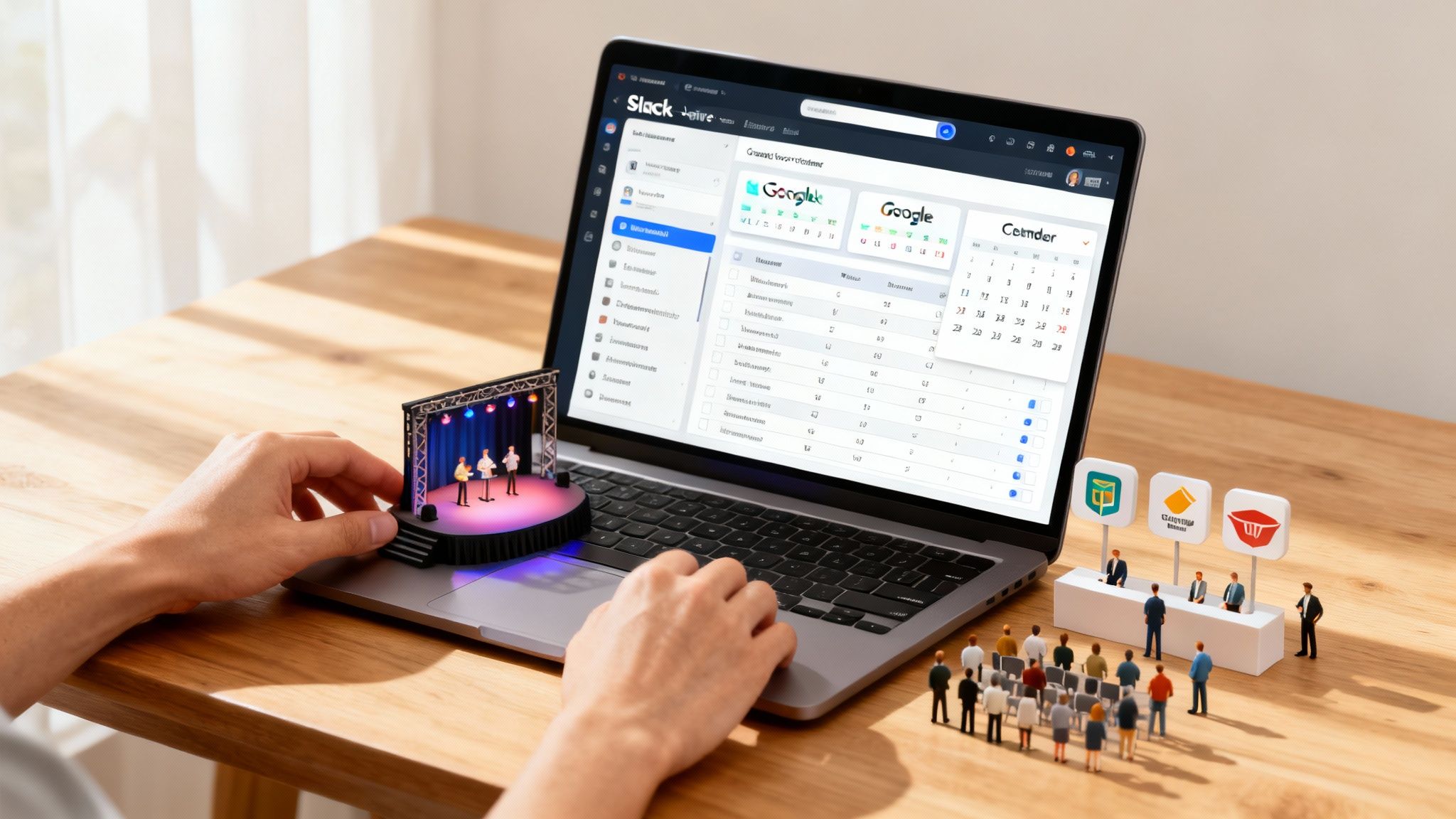Ever wonder what turns a great event idea into a flawless, memorable experience? That’s where event coordination comes in.
It's the nitty-gritty, hands-on work of making sure every single detail of an event plan actually happens. Think of it this way: an architect designs the blueprint for a skyscraper, but it’s the construction manager on the ground who makes sure the steel gets delivered, the crew shows up, and the whole thing gets built right.
What Is Event Coordination

While event planning is about the big picture—the "what" and "why" of the event—coordination is all about the "how." It's the real-time, boots-on-the-ground management of vendors, schedules, and all the moving parts that need to come together perfectly. The coordinator is the one turning a brilliant strategy into a living, breathing event.
And it’s a booming field. As more businesses invest in live and virtual experiences, the global events industry hit an estimated value of $1.19 trillion in 2024. Projections show it could more than double by 2035, all thanks to the growing demand for unforgettable events.
Event coordination acts as the central nervous system for any event, ensuring every supplier, speaker, and system works in perfect harmony. Without it, even the best-laid plans can quickly fall apart.
Even for internal company events, the coordination can get surprisingly complicated. You're juggling schedules, sending out endless communications, and chasing down RSVPs. This is where modern tools really shine. For companies that use Slack and Google Calendar, a tool like Be There is particularly useful. It integrates the entire process directly into the platforms your team already uses, connecting Slack conversations with Google Calendar invites to make coordination feel almost automatic and incredibly handy.
If you want to zoom out and look at the bigger picture first, our guide on how to do event planning is a great place to start. For another excellent resource, check out this ultimate guide for planning the perfect event.
The Core Pillars of Modern Event Coordination

Successful event coordination isn’t just about making sure things get done. It's a complex discipline that rests on a few fundamental pillars. When you understand these, you can see how a great idea transforms into a memorable, seamless experience.
Think of these pillars as the foundation. Without a solid base in each area, even the most creative event concept can fall flat.
✦Table: Key Responsibilities in Event Coordination
To really get a feel for what a coordinator juggles, let's break down the essential tasks that fall under each pillar. The table below shows how the high-level concept connects directly to on-the-ground work.
| Pillar | Key Responsibilities | Example Task |
|---|---|---|
| Strategic Logistics | Mapping out all physical and technical details to create an operational blueprint for the event. | Finalizing the room layout and AV equipment placement. |
| Vendor Management | Selecting, negotiating with, and managing all third-party suppliers to ensure alignment. | Confirming arrival times and setup needs with the caterer. |
| Attendee Experience | Designing a smooth and engaging journey for every guest, from registration to follow-up. | Sending a clear "Know Before You Go" email to all attendees. |
| Budget Oversight | Tracking all expenses in real-time to stay within financial limits without cutting corners. | Approving a vendor invoice and logging it against the budget. |
| On-Site Execution | Actively managing the live event, solving problems as they arise to maintain a smooth flow. | Quickly finding a backup microphone when one fails. |
As you can see, the coordinator's role is incredibly dynamic, blending meticulous planning with quick, in-the-moment thinking.
✦From Blueprint to Live Action
Let's dig a little deeper into what these pillars look like in practice.
Strategic Logistics is the operational backbone. It's about more than just booking a venue; it’s about creating a detailed, minute-by-minute schedule, mapping out attendee flow, and making sure the Wi-Fi can handle 500 people streaming at once.
Then there's Vendor Management. This is all about relationships. A good coordinator doesn't just hire a caterer; they build a partnership. They negotiate contracts, communicate the vision clearly, and ensure every vendor, from the AV team to the security staff, knows exactly what's expected of them and when.
✦Focusing on People and Performance
Beyond the nuts and bolts, a huge part of coordination is about people. The Attendee Experience is paramount. How easy was it to register? Was the signage clear? Did they feel welcomed? A coordinator obsesses over these details to make sure every touchpoint is positive.
Of course, none of this happens without careful Budget Oversight. The planner might set the budget, but the coordinator lives in it day-to-day. They're the ones tracking every dollar spent, processing payments, and finding smart ways to save money without anyone noticing.
Finally, it all comes down to On-Site Execution. This is the big day—the live performance. When a speaker is stuck in traffic or a projector bulb burns out, the coordinator is the calm center of the storm, solving problems on the fly so the attendees never even know there was an issue.
Pulling all this off requires a special combination of abilities. To learn more, you can explore the essential skills for event planning in our guide.
How Technology Is Reshaping Event Coordination
https://www.youtube.com/embed/AVzJ-TOTxxI
Remember the days of clipboards, binders, and endless spreadsheets? They’re quickly becoming a thing of the past. Technology isn't just a nice-to-have for event coordinators anymore; it’s the command center for the whole operation. The surge in virtual and hybrid events has completely rewritten the playbook, making skills in digital platforms and online engagement absolutely essential.
This shift is more than just a trend. By 2025, hybrid formats are expected to be the go-to for nearly 75% of event planners. The virtual event market is also on a rocket ship, projected to more than double to $537.18 billion by 2029. It’s clear that knowing your way around the right tech is no longer optional.
✦The New Toolkit for Coordinators
Today’s coordinators have a whole new set of tools to wrangle the moving parts of an event. A big part of the job now is finding clever ways to make things run smoother, like using dynamic QR codes to enhance audience experiences and cut down on friction at live gatherings. When it comes to internal company events, the biggest headache is almost always communication.
Technology’s greatest impact is its ability to centralize communication and automate tedious tasks, freeing coordinators to focus on creating a memorable experience rather than chasing down RSVPs.
This is especially true for teams that live in Slack and Google Calendar. Trying to manage an event by bouncing between emails, calendar invites, and tracking sheets is a recipe for confusion and low turnout.
A tool like Be There is incredibly useful here because it cuts right through that chaos. It brings event management directly into Slack, the place where your team is already talking, and syncs seamlessly with Google Calendar to handle invites and reminders automatically. This integration is extremely handy for companies using both platforms, as it tears down the barriers to participation, ensures everyone sees the event, and helps turn internal get-togethers into a real success.
Streamline Your Events Inside Slack And Google Calendar

For any company that lives in Slack and Google Calendar, coordinating internal events can feel like herding cats. You’re juggling endless email threads, tracking RSVPs in messy spreadsheets, and sending out calendar invites that just get buried. It’s a scattered approach that creates confusion and kills excitement before the event even has a chance.
The real issue is that these old-school methods pull people away from where they actually get work done. When your team spends all day in Slack, making them jump over to their inbox or another website for event updates is just adding friction. Important details get missed, and RSVP rates drop simply because it’s a pain to respond.
✦Meet Your Team Where They Work
The best way to get people involved is to bring the entire event process into the tools they’re already using. That’s exactly what a Slack-native tool like Be There is built for. Instead of pushing everyone to yet another platform, it lets you create, announce, and manage your events right inside the Slack channels your team is already a part of. This is why it's so handy for companies using Slack internally.
This small change makes a huge difference. Announcements are right there in the channel, impossible to ignore, and employees can RSVP with a single click. Just like that, event planning becomes part of the natural flow of conversation instead of an interruption.
The secret to great internal events isn't a more complicated system—it's a simpler one that lives where your team already is. When you remove the hassle, you get more visibility and more people showing up.
✦The Power of Automated Syncing
The real magic for companies using both Slack and Google Calendar is when your event tool talks directly to your calendar. Be There connects right into Google Calendar, taking the most annoying parts of event management off your plate. This seamless integration is a game-changer for internal coordination.
Here’s how it changes the game:
- Automated Invites: Create an event in Slack, and Google Calendar invites go out automatically. No more manual entry.
- Real-Time RSVP Tracking: When someone RSVPs in Slack, the Google Calendar event updates instantly. You always know exactly who’s coming.
- Smart Reminders: Automatic reminders get pushed out through Slack, keeping the event on everyone’s radar and making sure they actually attend.
This sync gets rid of all the manual back-and-forth, saving you hours of admin work and cutting out the human errors that lead to double-bookings or wrong attendee lists. It’s worth taking a look at the different Google Calendar sync options to see how you can dial in your process even more. By bringing everything together in Slack and Google Calendar, you create one smooth, simple system that makes running internal events feel effortless.
✦Closing the Gaps in Communication and Engagement
Even the most experienced event coordinator knows the feeling. You've planned everything down to the last detail, but then the inevitable happens: last-minute schedule changes, a key stakeholder is out of the loop, or the RSVP count is terrifyingly low. These are the classic hurdles that can turn a great plan into a stressful mess.
More often than not, these problems stem from a fragmented process. When your team chats are in one app, the event calendar is in another, and RSVPs are buried in email threads, it's a recipe for disaster. Important details get lost, and wires get crossed—especially for internal company events where announcements disappear in a flood of other messages.
One of the biggest headaches with internal events is just getting people to show up. You pour weeks of effort into planning something special, only to be met with a slow trickle of RSVPs. It's usually not because people aren't interested; it's because the invitation was easy to miss.
The secret to boosting engagement is simple: meet your team where they already are. When you bring event announcements and RSVPs into the communication hub they use all day, every day, you make it effortless for them to see it and respond.
This is where a modern tool can make a world of difference, particularly for companies that run on Slack and Google Calendar. A platform like Be There is incredibly handy because it integrates the entire event process directly into the Slack channels your team lives in. Instead of sending an email that gets buried, you can create and manage events right where the daily conversation is already happening.
The integration with Google Calendar also means RSVPs and reminders are handled automatically, so you can stop chasing people down. This approach doesn't just centralize your workflow; it dramatically boosts visibility and makes it incredibly simple for everyone to respond. By using a tool like Be There, you can get ahead of these common hurdles and turn potential crises into minor bumps in the road.
Is a Career In Event Coordination Right For You?

Thinking about jumping into the world of event coordination? It’s an incredibly rewarding career, but it’s definitely not for everyone. Forget the glamorous parties—the real work is mastering the art of controlled chaos behind the scenes.
Success in this field comes down to having grace under pressure. You have to be the calmest person in the room, even when a key vendor is running late or the AV equipment suddenly dies. That composure, paired with an obsessive eye for detail, is what keeps everything from typos on name badges to last-minute schedule changes from derailing the entire event.
✦What It Really Takes to Succeed
A career in event coordination is perfect for anyone who loves a fast-paced, high-energy environment. You’ll put in long hours leading up to an event, but that’s followed by the incredible satisfaction of watching a complex plan come together without a hitch.
So, what traits do the best coordinators share?
- Masterful Communication: You need to be able to convey information clearly and calmly to everyone involved—from vendors and speakers to attendees and your own team.
- Unflappable Problem-Solving: Things will go wrong. The best coordinators can think on their feet and find a solution before anyone even notices there was a problem.
- Meticulous Organization: You’re the ringmaster of a multi-ring circus. Juggling dozens of moving parts without dropping a single ball is the name of the game.
The real reward of event coordination isn't just the successful event; it's knowing your preparation and quick thinking were the invisible forces that made it all feel effortless for everyone else.
If that sounds like you, the good news is that your skills are in demand. Employment for event planners is expected to grow by 5% over the next decade. That translates to about 15,500 job openings popping up each year.
You can dig into the specifics on career outlooks and salaries by checking out the in-depth data from the Bureau of Labor Statistics.
Got Questions About Event Coordination? We've Got Answers.
Let's clear up a few common questions that pop up around event coordination. These quick answers will help you grasp the core ideas and see how they play out in the real world.
✦Planning vs. Coordination: What's the Real Difference?
It’s easy to mix these two up, but they play very different roles. Think of it like making a movie.
The event planner is the director. They come up with the creative vision, write the script, and decide on the cast and locations. They're focused on the big picture—the what and the why.
The event coordinator is the on-set producer. They’re the ones on the ground, making sure the cameras roll on time, the actors have their props, and the entire production follows the director's script. They handle the logistical how and when to bring the vision to life.
✦How Do I Get More People to RSVP to Internal Events?
This is a classic problem. You plan a great company event, send out the email, and... crickets. The fix is usually surprisingly simple: stop making people leave their digital workspace to engage.
You have to meet your team where they already are. If your company runs on Slack and Google Calendar, an email announcement is like putting up a poster in a room nobody visits.
A tool like Be There is particularly handy for this. It brings the entire event process right into Slack. You can announce the event, gather RSVPs, and send reminders in the channels your team actually uses all day. The seamless sync with Google Calendar makes it a truly useful solution for companies using both platforms, as responding becomes a one-click affair—a surefire way to get more people to participate.
✦What Are the Top Skills for a Great Event Coordinator?
A lot goes into being a good coordinator, but a few skills are non-negotiable. The best ones are masters of organized chaos, able to put out a fire without anyone even smelling smoke.
If you want to excel, focus on these three things:
- Grace Under Pressure: Things will go wrong. The mark of a great coordinator is the ability to solve a problem on the fly without breaking a sweat.
- Obsessive Organization: You're juggling dozens of moving parts—from vendor contracts to attendee dietary needs. A meticulous, almost fanatical attention to detail is crucial.
- Crystal-Clear Communication: You are the central hub for information. Keeping everyone from the catering team to the CEO in the loop calmly and clearly is the secret sauce.
Ready to make your internal events impossible to miss? See how Be There can simplify your event coordination process right inside Slack. Take a closer look at Be There.

Planning your internal events has never been easier!
No more scheduling headaches—our Slack-connected web app keeps things simple. Less email, more fun! 🚀
